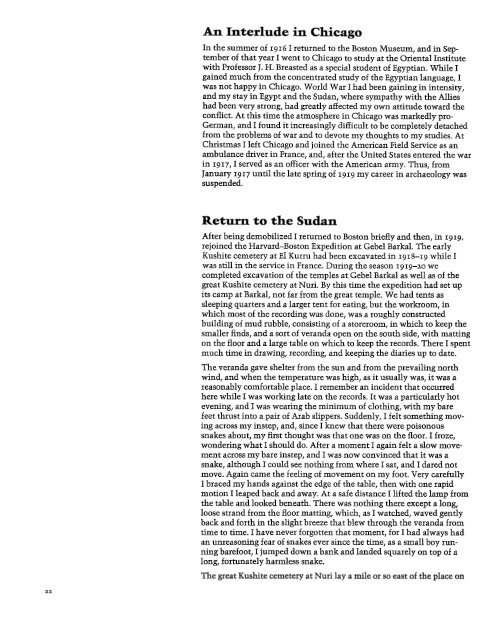Dows Dunham Recollections of an Egyptologist
You also want an ePaper? Increase the reach of your titles
YUMPU automatically turns print PDFs into web optimized ePapers that Google loves.
An Interlude in Chicago<br />
In the summer <strong>of</strong> 1916 I returned to the Boston Museum, <strong>an</strong>d in September<br />
<strong>of</strong> that year I went to Chicago to study at the Oriental Institute<br />
with Pr<strong>of</strong>essor J. H. Breasted as a special student <strong>of</strong> Egypti<strong>an</strong>. While I<br />
gained much from the concentrated study <strong>of</strong> the Egypti<strong>an</strong> l<strong>an</strong>guage, I<br />
was not happy in Chicago. World War I had been gaining in intensity,<br />
<strong>an</strong>d my stay in Egypt <strong>an</strong>d the Sud<strong>an</strong>, where sympathy with the Allies<br />
had been very strong, had greatly affected my own attitude toward the<br />
conflict. At this time the atmosphere in Chicago was markedly pro-<br />
Germ<strong>an</strong>, <strong>an</strong>d I found it increasingly difficult to be completely detached<br />
from the problems <strong>of</strong> war <strong>an</strong>d to devote my thoughts to my studies. At<br />
Christmas I left Chicago <strong>an</strong>d joined the Americ<strong>an</strong> Field Service as <strong>an</strong><br />
ambul<strong>an</strong>ce driver in Fr<strong>an</strong>ce, <strong>an</strong>d, after the United States entered the war<br />
in 1917, I served as <strong>an</strong> <strong>of</strong>ficer with the Americ<strong>an</strong> army. Thus, from<br />
J<strong>an</strong>uary 1917 until the late spring <strong>of</strong> 1919 my career in archaeology was<br />
suspended.<br />
Return to the Sud<strong>an</strong><br />
After being demobilized I returned to Boston briefly <strong>an</strong>d then, in 1919,<br />
rejoined the Harvard-Boston Expedition at Gebel Barkal. The early<br />
Kushite cemetery at El Kurru had been excavated in 1918-19 while I<br />
was still in the service in Fr<strong>an</strong>ce. During the season 1919-20 we<br />
completed excavation <strong>of</strong> the temples at Gebel Barkal as well as <strong>of</strong> the<br />
great Kushite cemetery at Nuri. By this time the expedition had set up<br />
its camp at Barkal, not far from the great temple. We had tents as<br />
sleeping quarters <strong>an</strong>d a larger tent for eating, but the workroom, in<br />
which most <strong>of</strong> the recording was done, was a roughly constructed<br />
building <strong>of</strong> mud rubble, consisting <strong>of</strong> a storeroom, in which to keep the<br />
smaller finds, <strong>an</strong>d a sort <strong>of</strong> ver<strong>an</strong>da open on the south side, with matting<br />
on the floor <strong>an</strong>d a large table on which to keep the records. There I spent<br />
much time in drawing, recording, <strong>an</strong>d keeping the diaries up to date.<br />
The ver<strong>an</strong>da gave shelter from the sun <strong>an</strong>d from the prevailing north<br />
wind, <strong>an</strong>d when the temperature was high, as it usually was, it was a<br />
reasonably comfortable place. I remember <strong>an</strong> incident that occurred<br />
here while I was working late on the records. It was a particularly hot<br />
evening, <strong>an</strong>d I was wearing the minimum <strong>of</strong> clothing, with my bare<br />
feet thrust into a pair <strong>of</strong> Arab slippers. Suddenly, I felt something moving<br />
across my instep, <strong>an</strong>d, since I knew that there were poisonous<br />
snakes about, my first thought was that one was on the floor. I froze,<br />
wondering what I should do. After a moment I again felt a slow movement<br />
across my bare instep, <strong>an</strong>d I was now convinced that it was a<br />
snake, although I could see nothing from where I sat, <strong>an</strong>d I dared not<br />
move. Again came the feeling <strong>of</strong> movement on my foot. Very carefully<br />
I braced my h<strong>an</strong>ds against the edge <strong>of</strong> the table, then with one rapid<br />
motion I leaped back <strong>an</strong>d away. At a safe dist<strong>an</strong>ce I lifted the lamp from<br />
the table <strong>an</strong>d looked beneath. There was nothing there except a long,<br />
loose str<strong>an</strong>d from the floor matting, which, as I watched, waved gently<br />
back <strong>an</strong>d forth in the slight breeze that blew through the ver<strong>an</strong>da from<br />
time to time. I have never forgotten that moment, for I had always had<br />
<strong>an</strong> unreasoning fear <strong>of</strong> snakes ever since the time, as a small boy running<br />
barefoot, I jumped down a b<strong>an</strong>k <strong>an</strong>d l<strong>an</strong>ded squarely on top <strong>of</strong> a<br />
long, fortunately harmless snake.<br />
The great Kushite cemetery at Nuri lay a mile or so east <strong>of</strong> the place on<br />
22

















